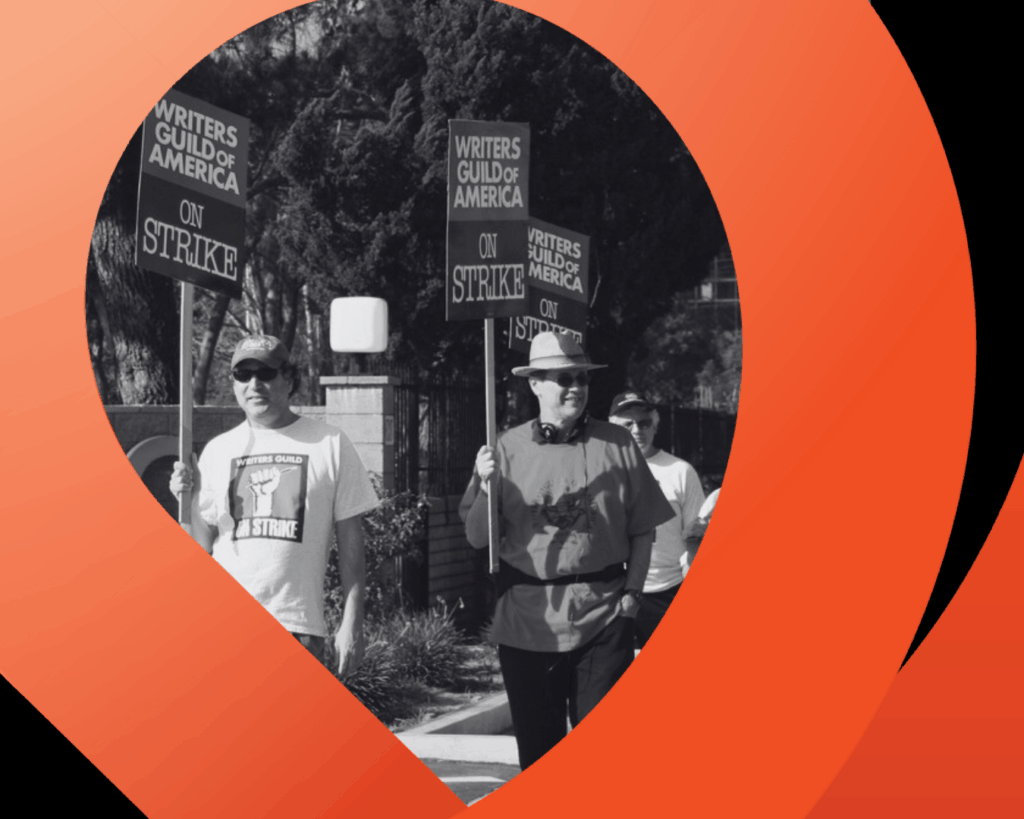Chapter 6 - Two Strikes and a Near Miss

You can check out the other chapters of the series at https://quester.com/perspectives/
You have no doubt seen plenty of news articles and debates this summer about the ongoing strikes of both the actors’ (SAG-AFTRA) and writers’ unions (WGA). We also had a strike averted when UPS agreed to terms with its union. As with many situations like this that touch so many people (not only the unions themselves but the rest of us who benefit from their work), there are a lot of emotions and narratives on both sides. However, there is a distinct difference between UPS and the actors/writers—the relatability of their unions to the general public.
As with other chapters of Assume and Doom, we’re not here to pick sides, only to show the narratives surrounding these issues.
Assumption: The majority of the public will side with the employees or unions during a strike.
VERDICT: It all comes down to how relatable the unions are or how connected the public feels to them.
Let’s start with the near miss of the UPS strike. From the beginning, UPS was never going to win the battle of public opinion. And other major companies with workforces like UPS should have been paying attention: there is a lot of hope and even warning that companies like Amazon and FedEx should increase the benefits and pay for their own workers. There is a feeling this could cause a chain reaction of better things for union workers in general.
I drive for FedEx, it\’s a pipe dream, but I hope this could be a sign for my company to do better by us too. Rooting for you!
I hope this next contract we get sets a precedent going forward. I really hope you guys and Amazon start to see the power of workers coming together against unfair labor practices and can organize.
Retired IBEW here (last September). Previously worked for a company doing the same thing for quite a bit less money (1/3 less). If I had stayed with the old company, I’d still be working. Strength in numbers. Let people see how long their Amazon (and other) packages take to arrive without UPS. Think what would happen if FedEx struck at the same time.
Secondly, the UPS worker is more relatable to the average person, as they interact with these workers every day. Everyone has had dealings with UPS workers, and we can understand exactly what the challenges are, which were reinforced by the stories put out by the union prior to the agreement: long hours, old vans that don’t have air conditioning, underpaid employees, and benefits in need of improvement – these are all very tangible.
The other relatable part is during the pandemic, these types of workers were performing superhero tasks. Taking on the burden of extra packages and doing it sometimes at the risk of their own health was really admired. There is a sense that delivery drivers did the heavy lifting while the CEOs had record profits and have not shared the wealth with the workers nor bettered their working conditions.
UPS had record profits directly from working their employees to the bone during the pandemic. Now they’re trying to cut salaries. F*%# ‘em up, lads.
And that’s the answer. All workers want is a fair share. Safe conditions, reasonable hours, respectful treatment, and fair pay – nobody wants to cripple the company, corporate persecution complex is totally out of control.
In corporate America, there’s never enough profits for the CEOs, stockholders, and owners. They always want more. I think it’s called GREED.
Many believed that even if the union had gone on strike, it would not have threatened their way of life, the way UPS and some of the media said it would. There are other ways to get things, and at the very least, they may have to settle for a delay. Those would have been acceptable downsides in the short term. Some people even asked how they could help.
Thank you guys for doing a tough job. My stuff may be delayed, but I stand with y’all in solidarity
I live in Phoenix and would love to bring y’all some waters and stuff if the strike starts. Do you know where you will be and how many people will be picketing?
SAG and WGA Strike
Before we get to the differences, one area that connects the UPS, SAG, and WGA unions is “the man”. The studio bosses and corporate heads are seen as greedy, evil, and making money on the backs of workers who may not even be sure where their next meal is coming from, or may also be under threat of safety issues.
With that being said, there are several differences we found between the UPS situation and the SAG/WGA strike.
At its best, the narratives are in favor of the actors and writers, but the tone and type of conversations are different. The plight of writers and actors sometimes becomes lost in conversations where AI is debated, such as the use, reality, and ethics. The conversation may start out about the strike, but when the AI technology issue is brought up (which is one of the main sticking points of the strike), it loses the public in a sea of confusing and uninteresting techno jargon.
Hey, we will like the AI less when they are sued to death for using an AI rehash of established material. Because that’s what they have to work with. We are going to have NIL and copyright suits stacked to the sky.
The capabilities of AI-generated media is waaaaaaaaaaaaaaay overestimated, mostly because the people pushing AI-generated content as a usable tool right now are more or less scammers who moved on from crypto to “AI”.
The SAG and WGA strikes also haven’t brought out the pro-union folks as much as the UPS situation did. It may be that the average union worker/supporter doesn’t really engage personally with people in the entertainment business. Many think of unions as skilled workers who create something tangible or offer a service that involves goods, or an immediate benefit—pipefitters, electricians, plumbers, drivers, and factory workers. Unions lean more into blue-collar work, and Hollywood definitely has a sparkly-collar vibe. That doesn’t mean union conversations don’t come up, but again, like AI, a lot of the union conversations go somewhere else and don’t focus on the writers/actors. It is more about the societal overall shift.
The public doesn’t see the threat of the Hollywood strike like they did the potential UPS strike—even though people were willing to ride it out in the short term. People don’t always deem entertainment as a necessity. Add to that, there is so much out there to watch. Many people can’t fathom running out of movies or series to watch. The strike is affecting the public’s leisure habits, not disrupting their daily lives.
At worst, there is very little sympathy for the plight of the actors. For an industry whose foundation is storytelling, their stories are not finding a home with much of the public. There are two main reasons for this:
- When they hear the term “actors,” their minds immediately go to the likes of Tom Cruise, Scarlett Johansson, Dwayne Johnson, Meryl Streep, Matt Damon, and Sofia Vergara. Big stars who make insane amounts of money. What most do not understand is that only 12.7% of approximately 160,000 members of SAG make at least $26,700, the minimum amount required to qualify for the union’s health insurance. As SAG-AFTRA president Fran Drescher has said, “Remember, Tom Cruise and top people make their own deals. That’s not who we are striking for. We’re striking for the journeyman.”
- Even those who do understand that most actors are not wealthy and famous, there’s a feeling, similar to what Hyman Roth said in The Godfather Part II, “This is the life we’ve chosen.” If you choose to be an actor, you choose the ups and downs that go with it. They even have suggestions on how the actors can work together to help each other.
It’s difficult to feel any sympathy towards anyone who is looking to score that one big paycheck and live like royalty. It’s a long shot that resembles that of a chronic gambler that thinks “if only I can win the big hand just once” mentality. It’s a personal choice to live on the fringes, hoping to make it big in a business that is notoriously unfriendly to people seeking steady, meaningful employment.
(In response to a story about an actor who is cleaning houses to make ends meet after 15 years of trying to be an actor)…No one is making him stay in LA. He could move to somewhere where he can get a decent-paying job with a lower cost of living. He hasn’t had any recent success with paying acting gigs…maybe it’s time to think about a new profession.
Idk, I’ll bet most Americans are thinking “boo hoo, as if movie star John Cusack isn’t rich enough”. They won’t relate it to other situations.
I have an idea – how about the “stars” of these movies forego their multi-million dollar paychecks and everyone involved in the making of a movie get paid exactly the same? Isn’t that what they want from our society? equity? Then you’ll have some people complaining about socialism. Point is NO ONE is ever happy. All people do nowadays is complain, complain, and complain.
(Referring to the SAG narrative that most Hollywood jobs are “survival jobs”)…“Survival jobs” or what everyday Americans simply call “jobs”.
Think the big A-listers should come up with a Buddy system where they partner with a below the line crew person or a lower earning SAG member and then do dual interviews so people can see the faces and hear the stories of the Hollywood working class. Because for the vast majority, even people who by most metrics have ‘made it’, they’re still dependent upon fair labor deals to make a living wage. It’s too easy to dismiss the super successful stars as being greedy.
So, the Hollywood unions have some work to do to get more public support. The pro-union folks are all in for the service workers, and while there are conversations of union support for writers/actors, it isn’t with the same passion or brotherhood as it is for service workers.
Quester’s series “Assume and Doom,” presents some prevalent assumptions, then brings clarity to them using our intuitive and informative ability to dig into social narratives to see what consumers are saying about these issues. So many times, people on all levels within a company hear about trends and buzzwords or read one article about a topic and make assumptions based on limited information. They then sometimes make knee-jerk decisions that do not help their business. We’re here to bring clarity to current issues so companies don’t fall prey to the “Assume and Doom.”
While most social listening/analytics quantifies large ideas and metrics, Quester social narratives go underneath the numbers to explain consumer behaviors, emotions, and motivations. We focus on the deep “why,” offering insight into implications, directions, and whitespaces. Because all consumer decisions are influenced by narratives—what they hear, read, watch, and discuss; social listening or analytics may not fully explain, analyze, or break down how these narratives affect consumer behavior.
While sometimes these assumptions will be an easy “true” or “false,” in most cases, as is common with human behavior, we’re predicting there will be a lot of nuances. Issues like these generally are not black-and-white.
The quotes you see in these articles are pulled from the various social platforms from which we analyzed the narratives and are representative of many thousands of discussions about the themes, not as “one-off” quotes from a qualitative study.

